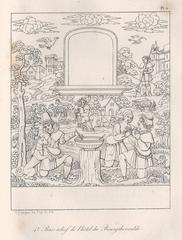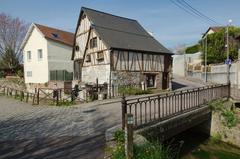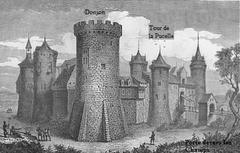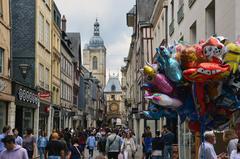
Tour Jeanne d’Arc Rouen: Visiting Hours, Tickets, and Historical Significance Guide
Date: 04/07/2025
Introduction: Tour Jeanne d’Arc in Rouen — History and Visitor Experience
Located in the heart of Rouen, France, the Tour Jeanne-d’Arc stands as an enduring symbol of the city’s medieval past and France’s national identity. As the last remaining vestige of the once-formidable Château de Rouen, this tower is intimately tied to the fate of Joan of Arc, one of France’s most revered historical figures. Built under King Philip II Augustus in the early 13th century, the tower’s massive walls and strategic position by the Seine River highlight Rouen’s central role as a military and political stronghold, especially during the Hundred Years’ War.
Most famously, the tower is forever linked to Joan of Arc: after her capture in 1430, she was imprisoned nearby and brought to the keep, where she was threatened with torture before her trial and execution in 1431. Today, the Tour Jeanne-d’Arc serves as a monument to resilience and faith, drawing visitors eager to discover the rich tapestry of Rouen’s history through interactive exhibits, guided tours, and immersive experiences. The tower is also a focal point during the city’s annual Fêtes Jeanne d’Arc festival, which brings history to life with reenactments and vibrant cultural events (French Moments, visiterouen.com).
This guide provides all the essential information on visiting the Tour Jeanne-d’Arc, including its historical significance, practical visitor tips, accessibility, nearby attractions, and highlights from Rouen’s lively cultural calendar.
Contents
- History and Construction
- Role During the Hundred Years’ War
- Joan of Arc’s Imprisonment and Trial
- Later History and Restoration
- Architectural Features
- Practical Visitor Information
- Visiting Hours
- Tickets and Prices
- Accessibility
- How to Get There
- Special Events and Photography
- Cultural Significance and Contemporary Role
- Nearby Attractions and Travel Tips
- Annual Events: The Fêtes Jeanne d’Arc
- FAQs
- Visual and Multimedia Suggestions
- Internal and External Links
- Summary and Recommendations
- References
History and Construction
Commissioned in 1204 by King Philip II Augustus after reclaiming Normandy from English rule, the Château de Rouen was designed as a major defensive stronghold. The Tour Jeanne-d’Arc, also known as the keep or donjon, was its most fortified section, with walls up to 4 meters thick and standing nearly 30 meters high (Atlas Obscura). As a critical part of Rouen’s defenses, the keep was intended as a last-resort refuge in times of siege (French Moments).
The Hundred Years’ War and the Tower’s Role
During the Hundred Years’ War (1337–1453), Rouen’s castle played a pivotal part in the conflict between English and French forces. The keep, later known as Tour Jeanne-d’Arc, was used as a prison and command post during English occupation in the early 15th century (Atlas Obscura).
Joan of Arc’s Imprisonment and Trial
Although Joan of Arc was not held directly in this tower but rather in the now-destroyed Tour de la Pucelle, the Tour Jeanne-d’Arc is the only surviving structure linked to her ordeal. Here, she was shown the instruments of torture during her trial in 1431—a psychological tactic to force her confession, which she bravely resisted. Her subsequent execution at Place du Vieux-Marché made the tower a powerful symbol of courage and martyrdom (French Moments, visiterouen.com).
Later History: Decline, Destruction, and Restoration
After the Hundred Years’ War, the Château de Rouen lost its strategic value. In 1591, King Henri IV ordered the partial demolition of the castle, sparing only the keep. The Tour Jeanne-d’Arc has since undergone restoration, notably in the 19th century, and even served as a bunker during World War II (French Moments). Today, it stands as a testament to Rouen’s layered history.
Architectural Features
The tower exemplifies medieval military architecture: a thick, cylindrical stone structure with narrow windows and a steep spiral staircase. Visitors can explore historical exhibitions and displays that recount Joan of Arc’s story and the castle’s broader history. The tower’s silhouette, capped with a pointed “witch’s hat” roof, is a distinctive landmark best viewed from Rue du Donjon.
Practical Visitor Information
Visiting Hours
- April to September: Daily from 10:00 AM to 6:30 PM
- October to March: Tuesday to Sunday, 10:00 AM to 5:00 PM
- Closed: Mondays (except public holidays), January 1, May 1, December 25
Visiting hours can vary due to special events or escape game bookings. Always check the official Donjon de Rouen website or Rouen city website for current information (solosophie.com).
Tickets and Prices
- Adults: €6
- Reduced (students, seniors): €4
- Children under 18: Free
- Family Pass (2 adults + 2 children): €15
Self-guided visits are sometimes free during standard hours; the escape game incurs additional fees and requires advance booking (rouen.fr).
Accessibility
- Mobility: The ground floor is wheelchair accessible, but upper levels (with spiral staircases) are not. Assistance is available on request.
- Facilities: No restrooms or cafés inside the tower; amenities are available in the nearby historic center (beyondyellowbrickblog.com).
- Recommended Attire: Wear sturdy shoes and dress in layers; the tower is cool and damp.
How to Get There
- By Train: 10–15 minutes’ walk from Gare de Rouen-Rive-Droite
- By Metro: “Vieux-Marché” station is closest
- By Bus: Multiple lines serve the historic center
- By Car: Paid parking available nearby; walking is the best way to explore the center
- By Public Transport: The Astuce network offers frequent service, and public transport is often free during festivals (visiterouen.com)
Special Events and Photography
- Escape Game: A popular immersive experience for groups (2–8 players), inspired by the tower’s history; book via the official site.
- Photography: Allowed inside (no flash/tripods); the tower’s exterior is a favorite photo spot.
- Best Times: Early morning or late afternoon for fewer crowds and better photos (triphobo.com).
Cultural Significance and Contemporary Role
The Tour Jeanne-d’Arc is a living monument, hosting exhibitions, escape games, and educational workshops that bring medieval history to life. It is central to Rouen’s annual Fêtes Jeanne d’Arc, a city-wide medieval festival that includes markets, parades, performances, and commemorative ceremonies (visiterouen.com).
Annual Events: The Fêtes Jeanne d’Arc
- When: End of May (May 29–31, 2025)
- What to Expect: Medieval markets with 150+ artisans, parades, concerts, fire shows, and the illumination of Notre-Dame de Rouen
- Family Activities: Storytelling, escape games, hands-on workshops
- Attendance: Over 200,000 visitors annually
- Transport: Free public transportation and extended services during the festival (official festival program)
Nearby Attractions and Travel Tips
- Historial Jeanne d’Arc: Immersive museum dedicated to Joan’s trial (historial-jeannedarc.fr)
- Place du Vieux-Marché: Execution site of Joan of Arc; home to a modern memorial (normandielovers.fr)
- Rouen Cathedral: Architectural masterpiece and festival focal point (thecrazytourist.com)
Combine your visit for a deeper dive into Rouen’s medieval heritage.
Frequently Asked Questions (FAQ)
Q: What are the Tour Jeanne-d’Arc visiting hours?
A: April–September, 10:00 AM–6:30 PM daily; October–March, 10:00 AM–5:00 PM Tuesday to Sunday. Closed Mondays.
Q: How much are tickets?
A: €6 adults, €4 reduced, free for children under 18. Escape games and some activities cost extra.
Q: Is the tower accessible for people with mobility issues?
A: Ground floor accessible; upper floors require navigating stairs.
Q: Are guided tours available?
A: Yes, in French and English, with options for educational workshops.
Q: Is photography allowed?
A: Yes, without flash or tripods.
Q: When is the Fêtes Jeanne d’Arc?
A: Annually at the end of May.
Visual and Multimedia Suggestions
- High-resolution images of the tower’s exterior (“witch’s hat” roof) and interior exhibitions
- Photos of Fêtes Jeanne d’Arc parades and medieval markets
- Interactive map showing the tower and nearby historical sites
- Virtual tour or 360° view links for online visitors
Summary and Final Recommendations
The Tour Jeanne-d’Arc offers a unique window into France’s medieval past, blending authentic architecture, interactive exhibits, and dynamic cultural programming. Its location near other key historical sites makes it an essential stop for any Rouen itinerary. Whether visiting for historical reflection or the high-spirited Fêtes Jeanne d’Arc, advance planning is recommended—check official sources for the latest details on hours, tickets, and events.
For a seamless experience, download the Audiala mobile app, follow Rouen’s official tourism channels, and consider combining your visit with guided tours and nearby attractions. The tower’s powerful story of resilience and national pride continues to inspire, ensuring a memorable journey into the heart of Normandy’s heritage.
References and Additional Resources
- French Moments
- visiterouen.com
- solosophie.com
- rouen.fr
- Atlas Obscura
- triphobo.com
- beyondyellowbrickblog.com
- historial-jeannedarc.fr
- normandielovers.fr
- thecrazytourist.com
- touristplatform.com
- Official Fêtes Jeanne d’Arc Website
- Public Transport in Rouen















